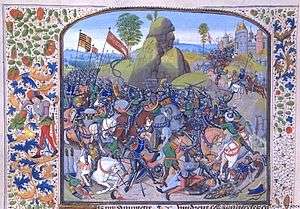Mos Teutonicus

Mos Teutonicus (Latin: the German custom) was a postmortem funerary custom used in Europe in the Middle Ages as a means of transporting, and solemnly disposing of, the bodies of high status individuals. The process involved the removal of the flesh from the body, so that the bones of the deceased could be transported hygienically from distant lands back home.
Background
During the Second Crusade for the Holy Land it was not thought fit for aristocrats who fell in battle, or died of natural causes, to be buried away from their homeland in Muslim territory.[1] The transportation of the whole body back from foreign parts over long distances was impractical and unhygienic due to decomposition, which was often accelerated by the climate.
German aristocrats were particularly concerned that burial should not take place in the Holy Land, but rather on home soil.[2] The Florentine chronicler Boncompagno was the first to connect the procedure specifically with German aristocrats, and coins the phrase mos Teutonicus, meaning ‘the German custom.’[note 1]
English and French aristocrats generally preferred embalming to mos Teutonicus, involving the burial of the entrails and heart in a separate location from the corpse.[3] One of the advantages of mos Teutonicus was that it was relatively economical in comparison with embalming, and was more hygienic.[3]
Corpse preservation was very popular in mediaeval society.[4] The decaying body was seen as a representative of something sinful and evil.[3] Embalming and mos Teutonicus, along with tomb effigies, were a way of giving the corpse an illusion of stasis and removed the uneasy image of putrification and decay.[3]
In 1270, the body of King Louis IX, who died in Tunis, which was Muslim territory, was subject to the process of mos Teutonicus for its transportation back to France.[3]
Process
The process of mos Teutonicus began with the cadaver being dismembered[3] to facilitate the next stage in the process, in which the body parts were boiled in water or wine[3] for several hours.[2] The boiling had the effect of separating the flesh from the bone. Any residual was scraped from the bones, leaving a completely clean skeleton.[2] Both the flesh and internal organs could be buried immediately, or preserved with salt in the same manner as animal meat.[3] The bones, and any preserved flesh, would then be transported back to the deceased's home for ceremonial interment.[2]
Mediaeval society generally regarded entrails as ignoble[3] and there was no great solemnity attached to their disposal, especially among German aristocrats.[2]
Prohibition of the practice
Although the Church had a high regard for the practice, Pope Boniface VIII was known to have an especial repugnance of mos Teutonicus because of his ideal of bodily integrity.[3] In his bull of 1300, De Sepulturis, Boniface forbade the practice.[4] The papal bull issued which banned this practice was often misinterpreted as prohibition against human dissection. This probably hindered the research of some anatomists as they feared repercussions and punishment as a result of medical autopsies but De Sepulturis only prohibited the act of mos Teutonicus, not dissection in general.
Further reading
- McDonald, Maggie (December 5, 2001). "Mayans not guilty of routine human sacrifice". New Scientist. Retrieved 2006-05-16.
- Brown, Elizabeth A. R. (1990). "Authority, the Family, and the Dead in Late Medieval France". French Historical Studies. Duke University Press. 16: 803 to 832. doi:10.2307/286323.
See also
References
Notes
References
- ↑ Keen, Maurice (September 10, 1986). Chivalry. Yale University Press. ISBN 0300033605.
- 1 2 3 4 5 6 Scäfer, Von Dietrich (1920). "Mittelalter Brauch by Der Überführung von Leichen". Sitzungsbrichte der preussischen Akademie der Wissenschafter. Akademie der Wissenschafter. XXVI: 478–489.
- 1 2 3 4 5 6 7 8 9 10 Westerhof, Danielle (October 16, 2008). Death and the Noble Body in Medieval England. Boydell Press. ISBN 1843834162.
- 1 2 Brown, Elizabeth A. R. (1981). "Death and the Human Body in the Late Middle Ages: The Legislation of Boniface VIII on the division of the Corpse". Viator. UCLA: Centre for Medieval and Renaissance Studies. XII: 223 to 270.
External links
![]() Media related to Death customs at Wikimedia Commons
Media related to Death customs at Wikimedia Commons